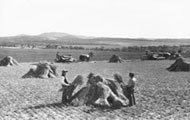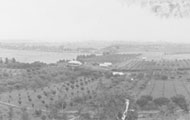- Agriculture
- Object :: Bush repaired Scoop
- Object :: Tumbling Tommy
- Interview :: Murray Smith
- Interview :: Peter Darley
- Windmills, pumps, steam power and engines
- Interview :: Max Jones
- Chaff Cutting
- Object :: Water Barrel
- Object :: Furphy Water Cart
- Ophir
- Object :: Gold Washing Cradle
- Object :: Picks and Mining Pan
- Object :: Chinese Scroll
- Object :: Chinese Shoulder Yoke
- Lucknow
- Historic Cadia
- Water at Cadia Valley Operations
- Interview :: John Ford
- Interview :: Joel Fossilo
- Object :: Testing Apparatus
Agriculture
Early settlers in the Orange district took up land surrounding local watercourses and marked unfenced boundaries initially by landmarks and later by a ploughed furrow. During good seasons they were also able to use unselected ground without water at no cost. As selections were taken up away from good water supplies, dams were dug to catch rainfall.

View Caption
Grazing was probably the first agricultural pursuit in the district with the pastures in the Orange district having supplied a huge number of fat lambs in addition to cattle and fine wool.
The seed wheat available to early landholders was susceptible to rust. However, by the middle of the 19th century, good yields were being harvested. Crop production (including potatoes and peas) was an important activity in the district. Even tobacco was successfully cultivated with a cigar factory established in 1865 to process it.
By the mid 19th century, the choicest varieties of English fruit trees were being established on the rich, volcanic slopes around Mount Canobolas. Cherries, grapes, apples, pears, peaches and plums as well as walnuts, chestnuts, hazelnuts and almonds were harvested. Table grapes were also grown (replaced now by wine grapes).
Steam engines were used in all facets of agriculture. A standard type was the portable steam engine, mounted on wheels and moved around by three or four horses. A Furphy water cart provided water for the steam engine. Steam engines were used for powering threshing machines, elevators, chaff cutters, feed grinders, sheep shearing stands and saw benches. Steam traction engines were used mainly by travelling contractors for threshing, chaff cutting, land clearing and occasionally ploughing. Steam engines required a steady supply of water and wood fuel and needed an experienced operator. Farmers also had to wait for the steam to be raised before work could begin.
The diversity of agricultural produce in the Orange district is reflected in today’s production of olives, nuts, venison, goat's cheese, lavender, eggs and berries. With such a rich agricultural heritage, it seems appropriate that the headquarters of the NSW Department of Primary Industries (formerly NSW Agriculture) was decentralised to Orange in the early 1990s.
